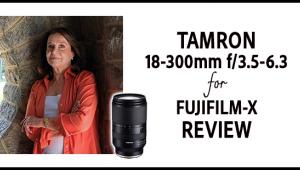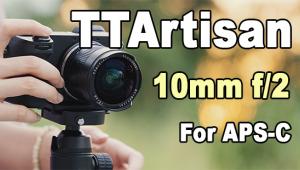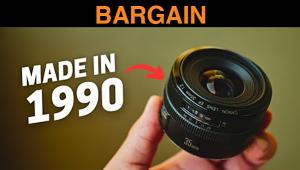Leica’s Summicron 75mm f/2; Is This The Ultimate Street Lens?
What do you want from a 75mm f/2 lens? Whatever it is, the new APO-Summicron-M Aspheric almost certainly delivers it--except, it must be said, low cost. Perfection, or as close as modern lens design can come to it, doesn't come cheap.
For reportage, it is superb: fast, compact, and convenient. Of course, you don't normally need or expect ultimate sharpness in fast reportage lenses: camera shake and fast film take the edge off ultimate resolution, which is why many people are happy with such things as old 85mm f/2 Russian Jupiters.
 |
But if you do want resolution, and bolt the camera down on a tripod, the Summicron delivers that, too. It is the only lens I have ever used that delivers 125 lp/mm (line pairs per millimeter), on the film more often than not. I say "more often than not" because at this level of resolution you are also testing the ability of the camera to focus properly and (which is much more difficult) to hold the film flat and in the same place every time. By f/5.6 the Summicron delivered 125 lp/mm (central resolution) on Ilford Pan F and Delta 100 with both an MP and a Bessa-T. This is unbelievable for such a fast lens.
With slide film--Kodak Ektachrome EBX IS0 100--central resolution never fell much below 80 lp/mm at any aperture though edge resolution (in the extreme corners, not 2/3 of the way out as it is often measured) dropped as low as 40-50 lp/mm at f/2 and did not hit 60 until f/2.8 or a little less. At the optimum aperture, f/5.6, it was 80 lp/mm at the corners!
As a bonus, the 75mm f/2 focuses close, to 0.7 meters (about 28"). This allows about 1/7 life size on the film, which is slightly superior to 90mm at 1 meter. Of course it is a state of the art design: aspheric, floating rear group, trick glasses including very high refractive index (two glasses) and anomalous dispersion (two glasses).
 |
|
|
Contrary to widespread belief (and indeed sloppy wording in Leica's own US press release) it is not a "short tele." Rather, it's just a small 75mm lens--and compactness is a large part of the appeal of Leicas as far as I am concerned. With a true tele, of course, at least one lens element is dedicated to reducing the physical size of the lens rather than to improving image quality. Here, they're all for image quality.
Funnily enough, until I got this lens for review, I had never been terribly enamored of the 75mm focal length. My "standard" lens is a 35mm f/1.4 Summilux, the last of the non-aspheric versions because it is so much smaller and lighter than the aspherics. When I want something longer, I normally switch straight to my 90mm f/2 Summicron: again, the last pre-aspheric.
The new 75mm Summicron changed my mind completely. I used it for landscapes; for architectural details; for people; for close-ups... In many ways, 75mm is the perfect complement to the 35mm Summilux, because it covers about 1/4 of the field of view, whereas the 90mm covers less than 1/6: a 35-75mm pairing is every bit as natural and easy as a 50-90mm combination. Also, a 75mm is a tiny bit easier to hold steady than a 90mm, though there is not much in it.
 |
 |
|
|
||
Of course, the Summicron isn't the only 75mm lens that Leica makes. There is also the f/1.4 Summilux, and if you can't live without the extra speed, you would have to go for that. But the Summilux is very much bigger and heavier; a good deal more expensive; doesn't focus as close; doesn't deliver the same image quality, especially close-up at wide apertures; and has razor-thin depth of field, and the Summicron's is small enough. Even with the 75mm f/2 Leica recommends the Viewfinder Magnifier 1.25x, especially with a 0.58x camera viewfinder. I had no trouble with the 0.72x finder but I'd have been happier still with the 0.85x. But to sum up this aspect of things, the Summilux is a very specialized lens indeed, while the Summicron is a real all-rounder.
In fact, the more I thought about this, the more sense the f/2 Summicron made. Yes, it will cannibalize some sales from the f/1.4 Summilux. But it will sell far more, in absolute terms, and I suspect that there are some people who will start out with a Summicron; find they really do want the extra speed; and go for a Summilux to replace it, thereby negating the cannibalism.
By now, and after looking at the pictures that accompany this report, you should have had one of three reactions. The first is a nod of recognition: there are shots you want to take that have similar requirements. The second is, "Oh, I never take pictures like that." And the third is to ask why I would want a super-expensive lens on a Leica when I could use a zoom, quite possibly on a digital camera.
Well, the first and the second do not require much further explanation. If this lens does what you want, and you can afford it, then buy it. If you don't need what it does, don't buy it. But the third may warrant a little explanation.
First, of course, there is quality. To equal the quality obtainable with this lens on fine-grained film, you would need at least 20 megapixels; I have seen it convincingly argued that if you wanted (for example) every hair on a model's head super-sharp, without "jaggies," you might even need 30 or more megapixels. On the other hand, with coarse-grained film and either a little camera shake or a little subject movement, you might not see the difference between this and as little as 6 megapixels.

















































